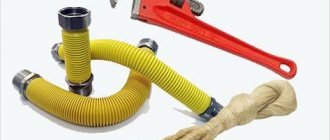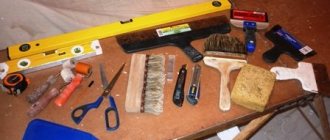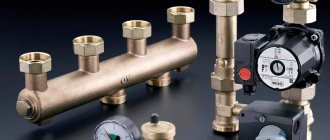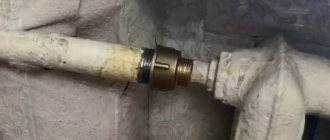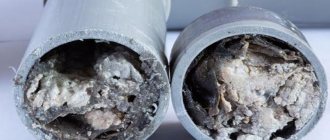Gas equipment requires special attention and accuracy in operation: we should not forget about the many examples of household gas explosions. In 2018, on December 31, a similar disaster destroyed 40 apartments, people found themselves under the rubble when the frost outside was below 20 degrees. Therefore, if any problems arise with gas equipment, the best solution is to call a specialist.
Quite often, the breakdown turns out to be minor - the tap on the stove, riser or column turns tightly. Often repairs come down to replacing the lubricant. The craftsmen prudently do not disclose the brand, but from GOST standards the Miss Clean resource found out how to lubricate a gas tap without compromising safety.
Linen
Sealing threaded joints using flax thread is one of the oldest and most proven methods. Linen is sold in any plumbing store and markets.
When purchasing, be sure to pay attention to the following signs:
- elasticity of the thread,
- no debris, no unpleasant odor,
- small thickness of strands.
Linen in its pure form begins to quickly rot upon contact with water, with temperature changes, and in heating systems it completely burns out. In addition, the material does not help prevent rusting of metal pipes and fittings, unlike more modern sealants.
To level out these shortcomings, the thread is impregnated with special compounds (pastes). Thickly grated natural red lead is often used. The cheapest option is to make the paste yourself by taking whitewash and adding drying oil until you get a mass like sour cream. It is applied to the linen thread in a thin layer, smeared and dried.
Red lead is more suitable for working with steel pipes: it oxidizes the top layer of iron to an insoluble compound that does not allow oxygen to pass through, working like a bluing process. Stores also sell ready-made flax thread sealant pastes:
- Unipak (soap, chalk, paraffin, water, mineral oil).
- Multipak (paraffin oil with mineral additives).
- Pastum GAS (organic binders, special fillers, additives and anti-corrosion additives).
- Gebatout 2 (white mineral oil, thickener, synthetic polymer, mineral filler).
If the specified means are not at hand, for better sealing of gas connections, you can impregnate the flax with ordinary oil paint or automotive sealants.
The work is done as follows: a strand of flax 2 matches thick is separated from a common skein, wound onto the thread, starting from the far end and ending at the end of the pipe. After this, the flax is coated with paste, the joint is assembled (when twisting, force should be felt).
Safety regulations
Working with gas equipment has an increased level of danger, so safety rules must be followed. When carrying out independent work to replace or repair a valve on a pipe, adhere to the following rules:
- All manipulations with gas equipment are carried out with open windows.
Mandatory air ventilation in the room when working with gas
- Electricity must be completely turned off throughout the apartment.
- During work it is prohibited to smoke or light matches.
- Repair work is carried out only during daylight hours, ensuring good daylight.
- The door to the room where equipment replacement activities are carried out must be tightly closed.
- The public access valve must not be closed. This increases the concentration of propane and the risk of explosion.
- It is better to do the work collectively. This will speed up the process and minimize errors.
- If the gas equipment and pipe are old and there are visible signs of corrosion, you should not carry out any manipulations yourself.
- It is necessary to provide the repair work site with fire-fighting equipment.
Having a fire extinguisher in the kitchen will ensure safety in the home.
Compliance with safety rules is not just a requirement for reinsurance. These measures will help keep the home and people's health safe and sound.
So, replacing a gas tap yourself requires the owner to have certain knowledge and skills in this area, the availability of the necessary tools, as well as reliable, high-quality lubricant for the tap. The sealant will allow you to safely use the gas valve and increase the service life of the entire system.
Non-hardening pastes
Another suitable sealant for gas or other pipes is a special non-hardening paste in the form of a viscous substance based on synthetic resins, acrylic and silicone, oils and various fillers. Such products are very easy to use: they need to be applied to the threads and the pipes are connected.
Positive qualities of pastes:
- the presence of additives against metal rusting,
- speed and ease of thread tightening,
- easy dismantling of the system,
- no thread jamming during assembly.
Unfortunately, such pastes are only suitable for pipes under low pressure. If the pressure is high, the composition will soon be squeezed out of the thread. You should also not rely on strong fixation of pipes, as well as on the resistance of the products to sudden changes in temperature or the effects of aggressive chemicals.
It is best to use non-hardening pastes with flax or artificial threads to increase the reliability of the joint.
Sealing of household air ducts
Ventilation in apartments and country houses is carried out using thin-walled elements. Often, air ducts are made of rectangular cross-section or from corrugated pipe. Threading on such connections is not possible. Therefore, sealing ventilation joints is carried out in other ways:
- through flanges,
- applying a bandage,
- using the socket method by inserting one air duct into another.
A flange connection is most often used for non-circular ducts. Sealing is carried out using gaskets made of soft material, for example, porous rubber. The shape of the gasket must match the cross-section of the air duct.
With other methods, the voids formed after joining the air ducts are filled with mastics whose temperature characteristics correspond to the operating conditions of the air line. Sometimes the joint of the air ducts is wrapped with self-adhesive tape.
Bandage clamps used for joining round air ducts
Solvent-based sealants
Such products undergo polymerization and completely harden some time after application. Curing occurs after the evaporation of the solvent present in the composition.
You can use sealants together with linen tape or on their own. Their advantages:
- serious level of fixation,
- strength and wear resistance of the seam,
- ease of installation of threaded connections,
- quick drying,
- low price.
Low quality materials may last slightly less, which is why the threads will have to be tightened periodically. If a thread gap that is too large is sealed with such a sealant, the seam will shrink over time.
Fighting the leak
Fixing a heating system leak using a sealant is a chemical fight against leaks.
The specified German sealant proved to be excellent in solving this dilemma. The following tools are also used:
- Resins with two components based on epoxy.
- Adhesive silicone compounds.
- Heat-resistant compounds based on rubber.
Their algorithm:
- The damaged area is degreased, dried, and covered with a thin layer of sealant.
- Next, it is wrapped with serpyanka. Serpyanka reinforces the sealed layer.
- The serpyanka is already covered with sealant. The action is repeated.
If a silicone product is used, then you do not need to use abrasives to grind the damaged area. And this type of sealant adheres better to a smooth surface.
Fluoroplastic tapes (FUM)
FUM tape, or fluoroplastic sealing material, is a unique product that is widely used in the construction of gas supply, water supply, heating and sewerage systems. Fluoroplastic is very strong and flexible, has a high melting point (about +400 degrees), is resistant to oxygen, aggressive liquids, and low temperatures (withstands up to –70 degrees).
PTFE tape or thread is not wetted by solvents, fats, or water. Remaining dry and durable, it can withstand increased pressure in the system. The material fills all the unevenness of the thread, reliably sealing it and sealing the joint. Stores sell threads with a diameter of 0.4–1.5 mm and ribbons with a width of 1–1.6 cm, so you can easily choose the appropriate option.
The material does not tolerate only regular and strong vibration: the connection loses strength, its tightness is broken. To improve the technical characteristics of the seam, FUM should be used in conjunction with silicone pastes or sealants.
FUM tape is wound in the same way as flax: along the thread with an increase in layer from the end of the pipe. The required number of turns is determined in each case individually and depends on the gap in the connection. Usually the thread is wrapped so that its relief becomes almost invisible, and serious force is applied during assembly.
General standards
First, it’s worth finding out under what circumstances gas pipes are used in the kitchen. The use of blue fuel in such a room most often means installing a stove. It's time to familiarize yourself with the terms of use. So, remember the main postulates:
- gas stoves are allowed to be installed in kitchens with a height of 2.2 meters (if the ceiling in the room is sloped, then to install the stove you should choose a place where it reaches the established norm);
- the kitchen should be equipped with a window with a window so that during the day repair work can be carried out without artificial lighting, ventilating the room (the presence of a functioning ventilation duct is welcome);
- between the slab and the opposite wall there must certainly be a passage with a width of 1 meter;
- ceilings and walls made of materials prone to combustion, according to standards, must be covered with plaster;
- The stove can be used in kitchens separated from the corridor by a secure wall/partition and door;
- The installation of gas pipes in the kitchen should be done so that the distance between the walls and the stove is at least 7 centimeters;
- branching to the slab is allowed only at the level of the connecting fitting;
- the shut-off valve should be installed at a level of 1.5 meters from the floor and at a distance of 20 centimeters from the side of the stove;
- To install the stove, it is permissible to use a special (heat-resistant - from 120 degrees) flexible hose and do not forget to change it, based on the recommendations specified in the product data sheet.
The standards for handling mainly already installed pipes and devices connected to them are indicated. If you plan to change, move, or even cut the gas pipe in the kitchen, then move on.
This is how you can hide a fragment of the network if it bothers you - without any transfer
Universal sealing thread
Universal threads are an improved version of FUM tapes and are made from more modern materials. Usually these are nylon impregnated with sealant, polyamide with silicone. They can be used in pipes supplying natural gas, compressed air, as well as in water supply and sewerage systems, including on wet threads and at sub-zero air temperatures.
The most popular brands of threads are:
- "Record",
- Sprint
- "Tangit Unilok"
- "Loctite 55".
Such threads are considered universal due to their ability to be used on metal and plastic, which is very important for modern gas pipeline systems. For these materials, the condition of the pipes is not important - they may even be rusty, old, or damaged.
After winding, the impregnated thread undergoes instant polymerization, and the connection can be put into operation immediately, without waiting time. This makes multi-purpose threads suitable for emergency repairs and emergencies.
Areas of responsibility
The first and main thing that the reader should pay attention to is that the inlet valve in the apartment falls under the responsibility of GorGaz or a similar organization operating in the area where you live. Both the repair and replacement of valves, and their periodic inspection, and the connection of gas equipment (stoves, boilers, convectors, hobs) should be handled by the mechanics of this organization.
Once again: you carry out all actions with gas equipment at your own peril and risk. The consequences of mistakes can be the most severe: a household gas explosion is perhaps the most terrible event in an apartment building, often turning it into a heap of construction waste. If you have even the slightest doubt about your ability to complete all the work, and to do it quickly and correctly, invite a specialist.
- you have quite a lot of experience in locksmith work; in particular, you have had to change valves and valves under pressure;
- you know where the power is cut off in your apartment, and you have access to the switchboard and the machines in it;
- the gas pipe in front of your valve has no visible signs of corrosion;
- at your disposal are plumbing tools (at least two gas wrenches No. 1 and/or No. 2), sealing material for threads and grease or graphite lubricant -
the following text will help you replace or repair the gas stove tap yourself.
Anaerobic adhesive sealants
Anaerobically curing gel sealants are ideal for sealing metal threaded connections. They penetrate even the smallest cracks and gaps and undergo polymerization when contact with oxygen ceases. Under normal conditions, sealants remain liquid for a long time, but as they harden, they turn into a durable mass like plastic.
Using anaerobic sealant is very simple. It can be applied to the thread with a brush or squeezed out of a tube, then smeared and tightened. After 15–60 minutes, the joint will be completely sealed, but another day must pass before the gas equipment can be used. The most popular brands of anaerobic compounds are:
- "SantechMaster"
- Loctite 577
- Loxeal 58,
- Unitec EASY.
Composition and capacity
Lubricants for industrial gas equipment include a liquid base and a thickener. The basis is:
- glycerol;
- petroleum oils;
- synthetic compounds.
Thickeners for compositions are salts of high molecular weight fatty acids or “soaps”.
To increase heat resistance and tightness, additives are included in the lubricant:
- mica;
- graphite;
- molybdenum;
- fluoroplastic chips and other components.
You can purchase lubricant in mini-packages or large containers. For example, Molykote 1102 is available for single use (50 g, 12 pieces per package), in containers weighing 1 kg and 25 kg.
The compositions are applied with a brush, spatula, gun, or using automatic equipment.
Gas pipe connection
Oversized steel pipes with welded seams are usually used for gas pipelines with a cross-section of ½–2. Pipes that are seamless are suitable for larger connections in a gas system. It is best to lay steel bituminized pipelines underground without seams, which have threaded joints rather than welded ones. The principle of adhesion of their parts is similar to that used for water pipes (like fittings). In this case, the sockets are sealed with modern sealants or flax with special impregnation.
It is not advisable to seal shut-off valves of gas pipelines, because in this case it will be problematic to open them in case of urgent need. Such taps should be tightly fitted to each other and closed manually or with keys. In basements, pipes are joined with clamps and brackets, and where they pass through the wall, they are protected with a special cover. In slag concrete masonry, the surface of the gas pipeline is additionally coated with insulating anti-corrosion paint.
Sealants for gas pipe connections are necessary compounds and devices, the use of which cannot be ignored. They ensure the proper level of reliability of joints and allow you to extend the service life of the equipment.
Usage
Here are a couple of examples of the use of plug taps
in their different versions.
- The most clear example is the samovar faucet. The plug in it is held in the valve body only by its weight.
Stopper of the samovar tap.
- Soviet-style water taps with a lever toggle switch were not very comfortable to use and often leaked; but they were almost indestructible. Breaking a lever or plug was a non-trivial task.
- Three-way plug valves were used for temperature control in residential areas: depending on the position, they allowed the flow of coolant through the battery, through the jumper, or completely blocked it.
Video description
Anaerobic adhesive sealant.
Tapes made from fluoroplastic
This material is also called FUM tapes. It is often used as a sealant when connecting pipes. Its important feature is that it is not wetted by water, fats, or solvents.
FUM tape for sealing joints Source kraska.guru
Characteristics
Sealing lubricants are divided into 3 types:
- Reinforcement.
- Threaded.
- Vacuum.
Reinforcement lubricants are intended for sealing fittings of gas mains, distribution stations, taps and threaded connections. Lubricants “For gas taps” are widely used, which include:
- base - castor oil;
- thickener - calcium soap.
There is also a more heat-resistant composition used for sealing shut-off devices in oil and gas fields - Armatol-238. It includes:
- base - emulsion of castor and synthetic oils;
- thickener - aerosil;
- graphite.
Lubricants have parameters (using the example of Armatol-238):
- Dropping point - shows the melting temperature of the thickener and the disruption of its structure, after which drop formation begins (160°C).
- Penetration indicator - reflects the thickness of the lubricant. It is equal to the number of mm of immersion of the measuring device cone, multiplied by 10 (10-1 at 25°C).
- Shear strength is the load at which irreversible disruption of the frame bonds occurs (up to 150 Pa).
- Viscosity - shows losses due to internal friction (less than 150 Pa-s at 0°C).
- Colloidal stability - the degree of release of oil from a lubricant under the influence of external forces and temperature (up to 15%).
- Corrosion stability - the ability to cause metal corrosion (—).
- Water content (up to 0.5%).
Also in lubricants, the degree of solubility in various chemical compounds, the content of foreign impurities, and main components are determined.
Thread lubricants are intended for sealing joint joints of pipes of pumping and compressor equipment, gas condensate wells. In industry, the use of the P-402 composition is widespread, which includes:
- petroleum oils;
- organosilicon compounds;
- thickeners in the form of lithium and aluminum stearates;
- graphite, zinc, copper, lead.
Thread compound is characterized by increased heat resistance (-50...200C), low moisture content (up to 0.1%).
If it is necessary to create a vacuum environment, use vacuum lubricants. They are unstable and can only be used at temperatures of -10...40°C, but they are distinguished by high water resistance and preservation characteristics.
Storing gas equipment in a warehouse involves the use of lubricants: gun lubricant (GOST 19537-83), as well as conservation oil (GOST 18974-73). In addition to purchased lubricants, they use compositions made from heated instrument oil and paraffin crumbs dissolved in it, as well as from wax, turpentine and anhydrous fat.
—
CONDITION 1
| RESULTS. â |
RESULTS RESULTS RESULTS. RESULTS ÑÐ±Ñ Ð¸ нанеÑÐµÐ½Ð¸Ñ Ð±Ð¸ÑÑмнÑÑ Ñлоев ÑовмеÑÐµÐ½Ñ Ð¸ Ð ²ÑполнÑÑÑÑÑ Ð½Ð° одной ÑÑÑÑÐ °Ð½Ð¾Ð²ÐºÐµ, ÑазмеÑаемой в конÑе поÑоÑной лиР½Ð¸Ð¸. â
| RESULTS. â |
RESULTS RESULTS ASSURANCE RESULTS. â
| RESPONSIBILITY, RESULTS °ÑÑка газо. â |
RESULTS, RESULTS ÑопиÑанной клеем. RESULTS RESULTS ¿Ð»Ð°ÑÑиковÑÑ Ð¾Ð± олоÑкÑ-бандаж. ROOM давлениÑ. â
RESULTS ¸Ð·Ð¾Ð»ÑÑионнÑм маÑеÑиалом. RESULTS. â
| RESULTS. â |
RESULTS s ROOM CONTENTS, CONDITIONS линии. â
| RESULTS. â |
ROOM CONTENTS , , , , , , , , ¾Ð»Ð¾Ñки; RESULTS OPTIONS . ROOM ROOM . â
RESPONSIBILITY ss, ss RESULTS CONCLUSION: 1) ROLLING UP, LOCKING ´Ð½Ð°Ð· наÑеннÑÑ Ðº гÑммиÑованиÑ; 2) RESEARCH, CONDITION; 3) RESULTS ROOM из ÑаолиÑа; 4) RESULTS з ÑекÑÑоѰолиÑа и дÑ. RESULTS, RESEARCHES ÑÑ ÑÑанение вÑÐµÑ ÑÑÐ¸Ñ Ð²ÐµÑеÑÑв. â
RESULTS RESULTS RESULTS. RESULTS ÑÐ±Ñ Ð¸ нанеÑÐµÐ½Ð¸Ñ Ð±Ð¸ÑÑмнÑÑ Ñлоев ÑовмеÑÐµÐ½Ñ Ð¸ Ð ²ÑполнÑÑÑÑÑ Ð½Ð° одной ÑÑÑÑÐ °Ð½Ð¾Ð²ÐºÐµ, ÑазмеÑаемой в конÑе поÑоÑной лиР½Ð¸Ð¸. â
| RESULTS. â |
→ RESULTS RESULTS RESEARCH Ñой, п ÑопиÑанной ÑпокÑиднÑм клеем. RESULTS RUR 50 RUR °Ñи и вÑÑе. RESULTS оÑиÑаÑÑ. â
